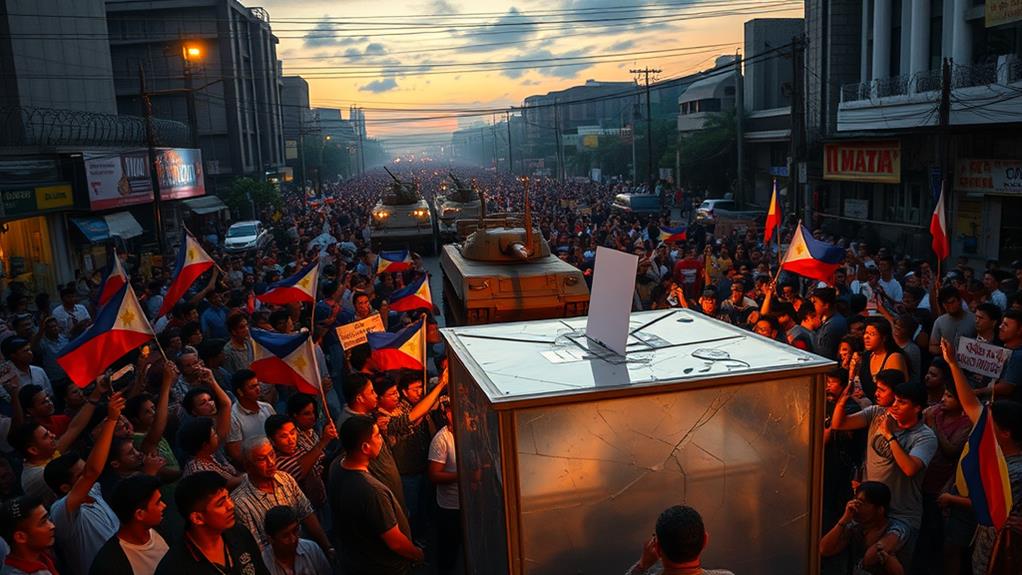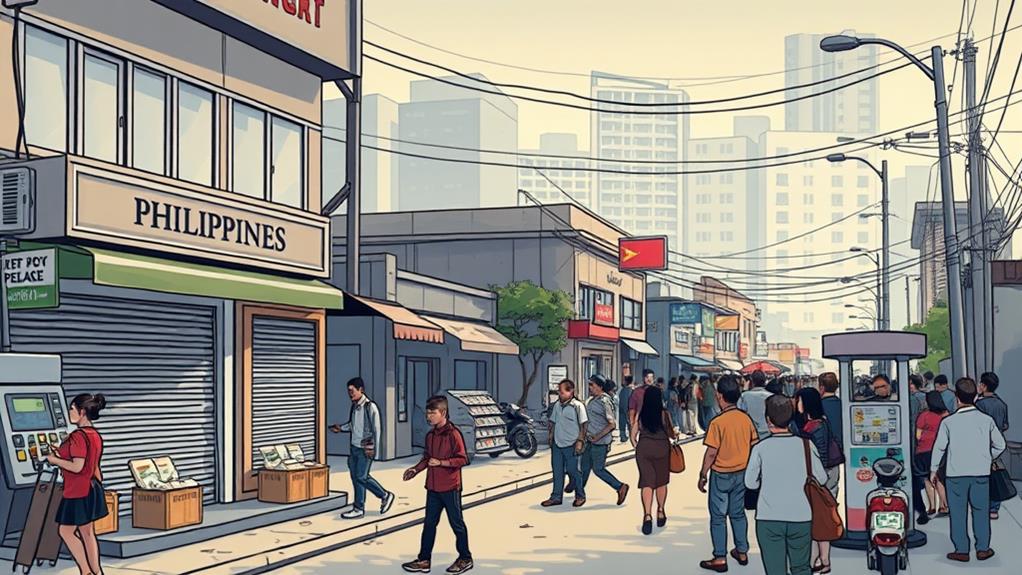Ferdinand Marcos declared Martial Law in 1972, marking the beginning of a 14-year authoritarian regime in the Philippines. This period was characterized by civil unrest, electoral fraud, and human rights abuses.
The 1983 assassination of Benigno Aquino Jr. sparked widespread outrage and fueled activism. The 1986 snap elections, marred by fraud claims, further intensified the protests.
Cardinal Jaime Sin mobilized millions of Filipinos, leading to the People Power Revolution. This revolution ultimately toppled Marcos' regime and installed Corazon Aquino as president.
Marcos' Rise to Power
Ferdinand Marcos' Rise to Power in the Philippines
In 1965, Ferdinand Marcos won his first presidential term, securing 52% of the vote and defeating incumbent Diosdado Macapagal, who received 43%. This election marked the beginning of Marcos' rise to power in the Philippines.
Marcos' popularity continued to grow, and he was reelected in 1969 with 61% of the votes. However, his victory was marred by allegations of vote-buying and electoral fraud.
During this time, civil unrest was on the rise, fueled by the emergence of the New People's Army in 1969 and the Moro National Liberation Front in 1972.
In response to the growing civil unrest, Marcos declared Martial Law on September 23, 1972, citing the need to suppress civil liberties and dissolve Congress. This marked the beginning of the Martial Law Era, which would have far-reaching consequences for the country.
The ratification of a new constitution in 1973 further solidified Marcos' grip on power, transitioning the government from presidential to parliamentary and earning him a reported 95% voter approval.
Assassination and Outrage
Assassination and Outrage
As Marcos' grip on power tightened, a dramatic event shook the nation. The assassination of Benigno Aquino Jr. on August 21, 1983, upon his return to the Philippines sparked widespread outrage and protests against Ferdinand Marcos' regime.
Key Events and Their Impact
| Event | Date | Impact |
|---|---|---|
| Assassination of Benigno Aquino Jr. | August 21, 1983 | Widespread outrage and protests |
| Formation of JAJA and KAAKBAY | 1983 | Galvanized opposition against Marcos' regime |
| Public mourning and yellow ribbons | 1983 | Symbolized collective protest against the dictatorship |
| Surge in activism and mobilization | 1983-1986 | Led to the People Power Revolution |
The outrage over the assassination led to a surge in activism and the eventual mobilization of the People Power Revolution, which aimed to challenge the Marcos regime. The assassination is often cited as a catalyst for the subsequent snap elections in 1986, which were marred by allegations of fraud and corruption, further fueling public discontent.
Election Fraud and Protests

The assassination of Benigno Aquino Jr. set the stage for a tumultuous 1986, marked by election fraud and protests that would ultimately bring down the Marcos regime.
The 1986 snap presidential election was highly contested, with Ferdinand Marcos declared the winner despite allegations of widespread electoral fraud and vote manipulation. Marcos was proclaimed the winner on February 15, 1986. However, significant discrepancies were found between the official count and the tally reported by NAMFREL, an election watchdog.
To further fuel the accusations of tampering, the Commission on Elections (COMELEC) technicians walked out in protest.
The election results sparked widespread protests demanding Marcos' resignation. Cardinal Jaime Sin played a pivotal role in mobilizing support for the opposition, calling on the public to join mass protests against the fraudulent election results and oppressive regime.
The protests escalated, with the people demanding an end to martial law and the Marcos regime. The fraudulent election results were seen as the final straw, leading to the People Power Revolution.
This revolution would eventually bring down the Marcos regime and pave the way for a new era of democracy.
The People Power Uprising
The People Power Uprising
From February 22 to 25, 1986, nearly two million Filipinos gathered on Epifanio de los Santos Avenue (EDSA) to protest against Ferdinand Marcos' regime, demanding an end to his 21-year rule and the restoration of democracy in the Philippines.
The Spark of the Revolution
The protests were sparked by allegations of electoral fraud in the snap elections, which fueled widespread discontent against Marcos' martial law and dictatorship.
This discontent was further fueled by the influence of Cardinal Jaime Sin, who mobilized the public and encouraged peaceful demonstrations.
Widespread Support
Various political, military, and religious groups lent their support to the movement, further galvanizing the crowds.
The nonviolent protests along EDSA ultimately led to the defection of military factions from Marcos, who refused to suppress the protests.
The End of Marcos' Rule
In the end, Marcos and his family, including his son Bongbong, fled to Hawaii on February 25, 1986, marking the end of his rule and the dawn of a new era for the Philippines.
Corazon Aquino's subsequent inauguration as the 11th President of the Philippines symbolized the triumph of the people's will against dictatorship.
Economic Crisis and International Response

The Philippine economy plummeted in the mid-1980s, with a contraction rate of 6.8% by the end of 1983. This crisis was largely caused by Ferdinand Marcos' mismanagement of the economy, which led to a national debt of approximately $28 billion by 1986, making the country vulnerable to the global recession.
Corruption and crony capitalism were key factors that contributed to the economic crisis. These practices led to a decline in agricultural productivity and an economic crisis in the late 1970s.
The assassination of Benigno Aquino Jr. in 1983 sparked widespread protests, highlighting the economic crisis and pushing for political reform.
The international community criticized Marcos' regime, with the U.S. Senate passing a resolution in February 1986 that condemned the electoral process and fraud in the snap elections. This criticism added pressure on the government to reform, ultimately contributing to the collapse of Marcos' rule.
The People Power Revolution in 1986 was a direct response to the economic crisis and human rights violations under Marcos' martial law.
How Did the American Colonial Period Influence the Implementation of Martial Law in the Philippines?
The american colonial period shaping modern philippines had a significant impact on the implementation of martial law in the country. The legal structure and policies established during this era influenced the way martial law was enforced, leading to long-term implications for the Philippines’ political and social landscape.
Legacy of Martial Law
The Marcos regime's downfall in 1986 didn't erase the legacy of Martial Law in the Philippines. This period of authoritarian rule has left a lasting impact on the country's politics and governance.
During Martial Law, approximately 70,000 individuals were imprisoned, and thousands were subjected to torture or extrajudicial killings. The EDSA Revolution in 1986 was a direct response to these oppressive conditions, symbolizing the people's fight for democracy and justice against tyranny.
The legacy of Martial Law continues to affect contemporary politics. Debates about accountability for past abuses persist, and many victims still seek justice decades later.
The dictatorship's legacy remains a hurdle to achieving genuine democracy. The economic mismanagement during Martial Law contributed to a national debt crisis, which has had lasting effects on the Philippines' economic landscape and governance challenges in subsequent administrations.
The struggle for accountability and justice is far from over. As the Philippines continues to grapple with the remnants of Martial Law, it's essential to acknowledge the past and work towards a more just and equitable future.
Questions and Answers
What Caused the People Power Revolution?
What sparked the People Power Revolution was a combination of factors.
The assassination of opposition leader Benigno Aquino Jr. in 1983 outraged the public and marked a turning point in the movement against the regime. This event was followed by the fraudulent snap presidential election in 1986, which further fueled the discontent and galvanized the opposition.
Years of suppressed civil liberties and human rights abuses created a culture of resistance.
The regime's restrictive policies and brutal suppression of dissent had been building up resentment among the population for years. This created an environment in which the opposition could unite and mobilize against the government, ultimately culminating in the toppling of the regime.
How Many Were Killed During Martial Law?
3,240 individuals lost their lives due to political violence and human rights abuses during the dark period of Martial Law in the Philippines.
This number is a sobering reminder of the atrocities committed during that time.
The deaths were part of a broader campaign of repression that had far-reaching consequences for the country.
What Happened During the Martial Law Era?
Suspension of Civil Liberties
During the martial law era, civil liberties were suspended, leading to widespread human rights violations. This resulted in approximately 70,000 individuals being imprisoned, with thousands subjected to torture or extrajudicial killings.
Media Censorship
The government censored media, suppressing freedom of the press, and controlled broadcasts. This restricted the flow of information and heavily influenced what the public knew.
Economic Consequences
Initially, the era saw some infrastructure development.
However, this was offset by severe mismanagement, resulting in rising national debt, inflation, and a decline in agricultural productivity. This led to widespread economic hardship and instability.
Opposition and Dissent
The restrictive regime sparked opposition and dissent among the population.
As the government's grip tightened, people began to resist and challenge the authorities, seeking greater freedom and democracy.
Why Was the Martial Law Important?
Martial Law was a pivotal event in the Philippines' political history. It drastically altered the country's political landscape by granting the president sweeping powers.
This led to the suppression of civil liberties, allowing the government to restrict citizens' freedoms and rights. For instance, the government dissolved Congress, eliminating the legislative branch and concentrating power in the executive branch.
Additionally, the president arrested political opponents, silencing opposition voices and consolidating control.
These actions resulted in a proliferation of human rights violations. The government's newfound powers led to widespread abuse, including arbitrary arrests, torture, and forced disappearances.
Economic mismanagement also ensued, as the government's focus on maintaining power led to neglect of the economy. This, in turn, led to widespread disillusionment among citizens, who felt their rights and freedoms were being eroded.